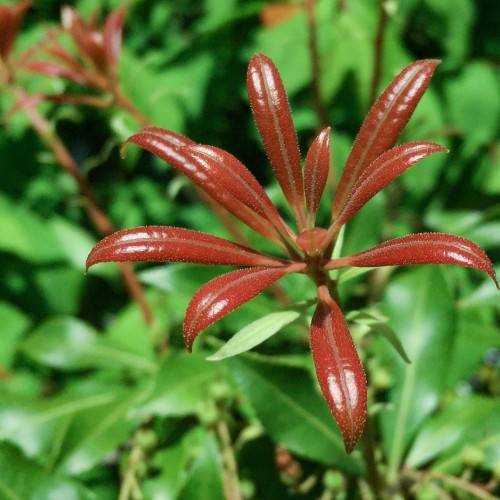
Japanese pieris
Pieris japonica 'Mountain Fire'
Also Known As - Japanese pierisCycle:
Perennial
Watering:
Average
Hardiness Zone:
5 - 8
Flowers:
Flowers In Spring
Sun:
Filtered shade, Full sun, Part sun/part shade
Soil:
Acidic, Well-drained
Fruits:
Fruits In Autumn Ready In
Leaf:
Yes
Growth Rate:
Low
Maintenance:
High
Drought Tolerant:
Yes
Care Level:
Medium
watering
Japanese pieris (Pieris japonica 'Mountain Fire') requires an average of 1 to 2 inches of water per week, either from rainfall or irrigation. It is important to not over-water this plant, as too much water will lead to root-rot and eventual plant death. Watering should be done at the root zone, with a water wand or soaker hose, to avoid wetting the foliage. Watering should be done in the morning or early afternoon to allow the plant time to dry out before nightfall. Deep waterings, once or twice a week, are recommended, as this will encourage the plant to develop deeper roots and become more resistant to drought.
sunlight
Japanese pieris (Pieris japonica 'Mountain Fire') is a broad-leaf evergreen shrub native to Japan that grows best in partial to full sun. It prefers bright, indirect light but will tolerate light shade. For best flowering, plant it in an area that gets at least 4-5 hours of direct sunlight each day, ideally in the morning or early afternoon, when the sun’s intensity is not as strong. When grown in very hot, humid climates, it may need some extra shade, especially during the hottest months of the year.
pruning
Pruning Japanese Pieris (Pieris japonica 'Mountain Fire') should be done twice a year: once in mid-summer and once in late winter. The first pruning should take place in mid-summer, after the plant has finished flowering and the new growth has started to develop. Cut away any dead or diseased branches and thin out overcrowded branches to allow airflow and sunlight to reach the inner part of the shrub. Trim away any branches that are growing out of the natural shape of the plant. The second pruning should take place in late winter, just before the plant begins to flower. During this time, you should remove any dead or diseased branches and thin out overcrowded branches. You can also prune any branches that are not flowering or that appear to be overgrowing the desired shape of the plant. Avoid pruning more than 1/3 of the plant’s total growth during this time.
